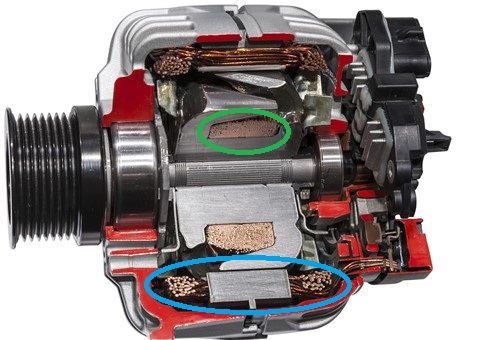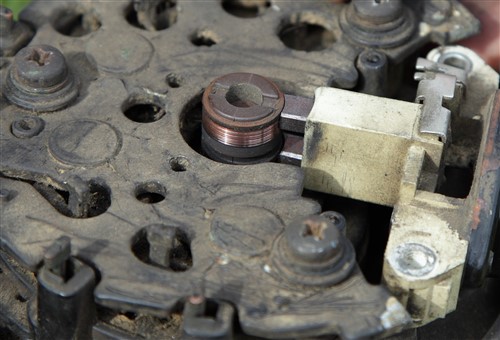
The outward appearance of alternators and other components in charging systems may not have changed much, if at all, during the past several decades but the truth is that alternators, in particular, have undergone vast changes over the last 20 years or so to make them more compact, lighter, and a whole lot more efficient than they used to be.
If you are new to the car repair industry, you may not be aware of just how much alternators and automotive charging systems have changed and developed over the last two decades to satisfy the demands of both modern automotive electrical systems and exhaust emissions regulations. For example, whereas the charging systems of 20 years ago were (for the most part) stand-alone systems, the majority of modern charging systems are not only controlled by the ECU and other control modules, but they are also very deeply integrated into vehicles' serial communications system(s) for diagnostic and control purposes.
So, with that said, in this article, we will take a closer look at modern charging systems, as well as some things to look out for when you encounter charging system issues on your customers’ vehicles. Before we get to specifics, though, let us revisit the subject of-

You have almost certainly seen the insides of an alternator before, so we need not spend time labelling and pointing out the various components that make up a typical alternator since all alternators contain the same parts, although some may look slightly different from the example shown here.
We all also know that alternators generate AC power when they rotate and that a series of diodes then converts the AC power into DC power that is fed into the battery. However, what many of us sometimes forget is that all alternators work because they all follow a universal law of physics, this law having been formulated by Michael Faraday in 1831.
In short, Faraday discovered the law of electromagnetism, aka electromagnetic induction, which states that {paraphrased], an electrical current can be induced in a length of wire when the intensity of a nearby magnetic field changes or moves.
Of course, we are not suggesting that all of us should have the finer points and nuances of all the laws of physics at our fingertips, but then again, when we diagnose electrical issues, it certainly helps to at least be aware of the most important laws and what they define. In this regard, alternators are the perfect case in point, because the electrical field in the rotor’s windings changes and moves all the time as the rotor rotates through the magnetic lines of force (aka magnetic flux) in the stationary windings of the field coils.
While the above describes the short version of how alternators work, it is important from our perspective as mechanics and technicians to understand that the output of any given alternator is determined by three things, these things being-
The relationships between the above factors are exceedingly complex and limited space precludes a comprehensive discussion of this topic but suffice to say that in simple terms, the output of an alternator can be increased by using-
By leveraging the advantages of each of the above possible choices, engineers are now able to produce alternators that are roughly 40 per cent smaller than they were 20 years ago, while at the same time, generating outputs of as high as 250 Amps, which brings us to-

We have all heard the term “smart alternator”, but have you ever wondered what is it that makes an alternator smart? Are these alternators somehow different from “dumb”, or non-smart alternators?
Well, no, smart alternators are no different from dumb or non-smart alternators. The “smart” part of the terms derives from the advanced control mechanisms that the ECU and other control modules use to control, adapt, and manage the alternator’s output. Here is how this works-
In all cases, an alternator's output is determined and regulated by the intensity of the field current that is supplied to the rotor by the voltage regulator. Therefore, and since the basic premise(s) of Faraday’s law remains constant, it is possible to manipulate an alternator’s output by varying the intensity of the field current to suit changing operational demands. As a practical matter, increasing the field current will induce a stronger magnetic field in the rotor, which will result in a higher output current of the field coils. By reducing the field current, the opposite happens; a weaker magnetic field is induced in the rotor’s windings, which results in a lower output current from the field coils.
So, depending on the demand for electrical power at any given moment, the control module that manages the alternator* will broadcast a command to adapt the strength of the field current over either a LIN or CAN network. The voltage regulator then adapts the field current and then uses the same communications network to both confirm the change and report on the overall health and status of the charging system.
*Depending on the vehicle, this module could be the ECU, the Body Control Module, or a dedicated Power Control Module.
In practice, smart alternators have numerous advantages. For example, a charging system can be programmed to remove the field current entirely during engine cranking, which reduces the load on both the starter and the battery. More to the point though, depending on the total electrical load on the battery during the operation of the vehicle, the alternator's output can be increased or decreased to match the total load (on the battery) exactly. While this ability reduces parasitic power losses, it also helps to extend the useful life of a well-used battery because the battery is never overcharged or undercharged.
This last point is crucially important because the overall health of a battery has a huge effect on the power management strategies an ECU might decide to adopt at any given time, because these kinds of strategies are based entirely on the capacity of the battery, as opposed to the amount of electrical energy the alternator can produce at any given time.
So, as a battery degrades and loses some of its capacity over time, the large electrical loads of a modern vehicle have a progressively greater effect on the battery's ability to keep all systems powered up. Thus, to compensate for a battery's reduced ability to provide a vehicle's electrical system with adequate power, all charging strategies take the battery's overall state of health into account. As a practical matter, this means that a "smart" alternator might charge a degraded battery at a reduced rate/current to prevent overcharging or that charging might be done in stages to prevent the degraded battery from overheating.
However, while these strategies can extend the life of a battery considerably, the problem is that over time, the charging system begins to learn these strategies and it will apply them to a new battery, which means that a new battery might remain chronically undercharged unless the charging system is reset after a battery replacement.
In practice, such a reset forces the charging system to recognise the new battery, which will necessarily have a charging profile that differs markedly from that of the old battery. It should be noted that failing to perform this required reset after a battery replacement will damage or even destroy the new battery in fairly short order, so be sure not to overlook this procedure when next you replace a battery in a modern vehicle.
We can conclude this section by saying that despite their several advantages, smart alternators and charging systems are a kind of contradiction in terms. On the one hand, smart charging systems were developed primarily to reduce fuel consumption and exhaust emissions by reducing parasitic power losses. However, it turns out that making alternators more efficient sometimes has the opposite effect.
Proof of the above is that most modern alternators consume roughly 0.298 kW per 25 Amps output, meaning that the 220 Amp alternators on some Chrysler models rob the engine of 2.60 kW, which might not seem like much for a large engine to sacrifice but a parasitic power loss of this magnitude produces measurable fuel consumption penalties for cars with small displacement engines. Of course, not all small cars have 220-Amp alternators, but anything that increases parasitic power losses on a 1.0L engine creates more emissions, which rather defeats the purpose of smart charging systems on small engines, which brings us to the topic of-
All hybrid and electric vehicles have two distinctly different electrical systems; the high-voltage system that provides motive power and a 12-volt system that provides power to the headlights, interior lights, the A/C compressor, high-voltage battery cooling/warming, power windows, etc, etc.
As a practical matter, the 12-volt battery must be charged, but since electric vehicles and hybrids do not have alternators, these vehicles employ various strategies to keep the 12-volt battery charged up. In practice, the most common strategy uses a DC-to-DC converter that draws power from the high-voltage battery and then steps it down to (typically) 14.5 volts to maintain the charge in the 12-volt battery.
We need not delve into the intricacies of modern DC-to-DC converters here, beyond saying that, unlike common transformers that use coils of copper wire to step down voltages, DC-to-DC converters use solid-state devices like capacitors and resistors as well as a sophisticated computerised control system that performs the function of a conventional alternator that can supply outputs as high as 130 Amps.
As a point of interest, it might be worth mentioning that Tesla began replacing the conventional 12-volt batteries in their vehicles with 15.5-volt lithium-ion batteries in 2021 that are both lighter and smaller than comparable lead-acid batteries. The reason given for the change is that lithium-ion batteries are better suited to the electrical architecture of Tesla cars but the problem with these batteries is that one needs highly specialised and hugely expensive test equipment to test or diagnose them. Not that many of us see many late-model Tesla models in our bays daily, if ever, but still, which brings us to-

Unlike in olden times, when many charging system issues could be resolved simply by cleaning and tightening battery terminals such as in the example shown here, diagnosing in modern charging systems has evolved into a specialized field of repair that requires an almost scientific approach. Moreover, this approach requires that one has access to (at a minimum) a multichannel digital storage oscilloscope to capture communication waveforms, a high-end scan tool, and a proper battery testing device that can test and analyse AGM batteries, which have now become the norm on new vehicles.
Other equipment and resources that could be helpful include a high-end digital multimeter, high and low-amperage amp clamps, a DLC break-out box, a relay tester, and perhaps most importantly, access to OEM-level service information in the form of wiring diagrams and pin-out charts.
Trying to diagnose issues on modern charging systems without the aid of the equipment listed above is extremely challenging if not always impossible but then again, you can save many hours of diagnostic time if you are aware of the charging system pattern failures that occur on many vehicle makes and models. There are far too many such pattern failures to list here, but we can do the next best thing, which is to discuss three extremely common pattern failures on popular vehicles. Let us start with-
Ford F150 issues
One of the most common issues on F150 trucks (regardless of the engine fitted) involves trouble codes P0625 – “Generator Field Terminal Circuit Low” and P065B – “Generator Control Circuit Range/Performance”. These two codes will typically illuminate the charging system warning light and the alternator will generate a steady 13.6-13.8-volt output, which seems strange, seeing that the field circuit/current appears to be abnormally low.
These codes indicate a loss of communication between the alternator’s internal voltage regulator and the ECU as a result of either corrosion in the alternator’s electrical connector, or the GEN RC or GEN L1 wires, which are the alternator’s communication circuits going to the PCM, having broken off near the bottom end of the engine. These wires are incorrectly routed so the engine's movement puts an undue strain on them. While these wires can be repaired, Ford prefers that the alternator harness be replaced with an OEM part to ensure the proper operation of the charging system.
Note that the reason why the alternator still develops a healthy charging voltage is that the voltage regulator enters a default mode when communication failures between itself and the ECU occur.
Dodge Ram issues
Many pre-2018 Dodge Ram 1500 trucks fitted with 5.7L V8 engines will unexpectedly (and repeatedly) set trouble code P2504 – "Charging System Output High", especially during engine cranking.
In this case, the problem involves either improperly tightened positive battery terminals or more likely, corrosion inside the cable that runs from the battery positive pole to the alternator. In most cases, there will be no visible signs that the cable is damaged to the point of uselessness, so the only reliable test involves performing a voltage drop test over the entire length of the cable while the alternator is in charge mode.
According to OEM service information, the voltage drop should be less than 0.2 volts, so be sure to file this info away for future reference.
Jeep Grand Cherokee issues
Many pre-2019 Jeep Grand Cherokee models will display an (unexpected) “Stop/Start Unavailable Service Stop/Start System” after a jump start. Note that the jump start need not be performed incorrectly for this message to appear- all that this required for the message to appear is a jumpstart.
For reasons that are not entirely clear, the number 5 fuse in the jumpstart remote post will almost always blow if the vehicle is boosted, so if the above message is present and the auxiliary battery will not charge, replacing the blown fuse will resolve both issues, which leaves us with this-
Diagnosing and repairing modern smart charging systems might seem like a daunting prospect, and sometimes it is just that- daunting and challenging. However, it always helps to remember that despite some differences in implementation, all smart charging systems are a) built around the same laws of physics and electricity, and b) all charging systems work in largely the same way. Therefore, modern charging systems fail for largely the same reasons.
In fact, there is no charging system in use today that is so different from any other charging system(s) in use that it cannot be diagnosed with the tools and equipment you’d use to diagnose any other electrical issue on a standard vehicle. Tesla vehicles might be the exception that proves this particular rule, but as we said elsewhere, not many among us deal with Tesla cars daily- if ever.
That said, though, we hope that this article has given you some new insights into modern charging systems- if only to show that smart systems are not smart. Smart charging systems are only conventional charging systems that are controlled by a computer, and once you’ve figured out the control part, you’ve won half the battle of resolving the issue you are dealing with.